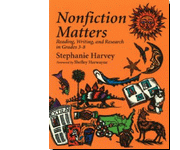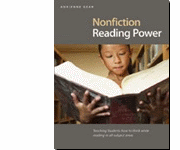
| All About the Middle Grades |  |
Nonfiction Reading and Writing
in the Middle Grades (Part II) |
Middle-grade educators in classrooms across the country are working to integrate more nonfiction works into the curriculum as part of the transition to the Common Core State Standards in English Language Arts.
In Part II of this MiddleWeb Special Report, we highlight some of the ways educators are teaching nonfiction reading and writing in today's classrooms.
In case you missed Part I of this report, published Tuesday, we also covered the relationship between nonfiction and the common core, including some of the specifics and reasoning behind the call to include more informational texts in instruction across the curriculum.
This two-part special report also includes a selection of valuable MiddleWeb resources for educators on nonfiction reading and writing.
If you don't receive MiddleWeb SmartBrief and find these reports useful, we urge you to sign up for our timely e-newsletter. MiddleWeb SmartBrief delivers the stories making news in your profession directly to your inbox -- for free. |
 | Breathe life into your students' research project writing! Knowing How gives you the tools and strategies to make research a process of inquiry and discovery, and not just an exercise in information gathering. Click here to read Chapter 1 online!
|
| Nonfiction in the Classroom
|  |  |
|
- Ideas for teaching fiction, nonfiction together
 English teacher Jessica Keigan in this blog post outlines a process by which educators can teach fiction and nonfiction and still meet the goals of the Common Core State Standards. Her model requires English teachers to collaborate with their counterparts in other subjects. For example, she and a social studies teacher worked together to teach students about persuasive writing and speaking and historical revolutions. "To address both topics, students read and analyzed fiction and non-fiction that addressed a specific theme -- revolution," she writes, noting that the key is not choosing between fiction "or" nonfiction, but rather including fiction "and" nonfiction in lessons. Education News Colorado/Voices blog
(3/11) English teacher Jessica Keigan in this blog post outlines a process by which educators can teach fiction and nonfiction and still meet the goals of the Common Core State Standards. Her model requires English teachers to collaborate with their counterparts in other subjects. For example, she and a social studies teacher worked together to teach students about persuasive writing and speaking and historical revolutions. "To address both topics, students read and analyzed fiction and non-fiction that addressed a specific theme -- revolution," she writes, noting that the key is not choosing between fiction "or" nonfiction, but rather including fiction "and" nonfiction in lessons. Education News Colorado/Voices blog
(3/11)





- Middle school embraces nonfiction, digital resources
Sixth-graders at Lincoln Public Schools in Nebraska will be able to use a hard-copy text or a digital device such as an iPad next year when reading nonfiction books about topics such as volcanoes as the district integrates changes to the curriculum with a move toward digital learning. The changes are aligned with the common core's focus on nonfiction and are part of the district's goal to create comprehensive digital classrooms. "Overall, we're really excited about this, because it helps us move forward in multiple directions," said Jane Stavem, the district's associate superintendent for instruction. Lincoln Journal Star (Neb.) (tiered subscription model)
(3/4)





- Teaching the power of writing through persuasive essays
Middle-school students can be asked to write persuasive essays about various complaints -- including school rules they believe are unfair -- retired educator Kathy King-Dickman suggests in this blog post. Letting students choose topics that matter to them can boost their enthusiasm and motivation, King-Dickman writes. "Whether it comes from a second-grader pleading for a later bed time or a ninth-grader asking the world to not pollute, students feel the power in exercising their right to write," she notes. Education News Colorado/Voices blog
(2/14)





- Newspapers used as middle-school classroom tool
Eighth-grade students in South Allegheny, Pa., regularly read local newspapers in class as part of the Newspapers in Education program. Among other things, the papers are used to analyze different types of writing, said middle-school reading teacher Janel Biagiarelli. "They've read so many stories, but they're just getting into informational text," Biagiarelli said. "It's a change -- getting away from stories into real-life stuff. So much of education now is focused on real-life application." Pittsburgh Tribune-Review
(3/8)





- Problem-solving for classmate leads to real changes
 Three Washington state students used a government assignment to write a piece of legislation to help their friend continue to play school sports. Their friend, Ike Ditzenberger, who has special needs, has been a student at Snohomish High School for more than four years -- making him ineligible to play school sports after this year. The students wrote the "Ike Act," which was greeted favorably by state lawmakers and prompted the school-sports governing board to re-evaluate its rules. KING-TV (Seattle)
(2/28) Three Washington state students used a government assignment to write a piece of legislation to help their friend continue to play school sports. Their friend, Ike Ditzenberger, who has special needs, has been a student at Snohomish High School for more than four years -- making him ineligible to play school sports after this year. The students wrote the "Ike Act," which was greeted favorably by state lawmakers and prompted the school-sports governing board to re-evaluate its rules. KING-TV (Seattle)
(2/28)





- Ill. sixth-graders mentored in writing by older students
 About 200 sixth-grade students at three charter middle schools in Chicago are being mentored in writing by a group of 100 high-school seniors in Bakersfield, Calif. Once a week, the 12th-graders read a range of assignments posted by the sixth-graders on a cloud-based platform and then send feedback to the younger writers. The virtual mentorship has benefited both groups, educators say. "It's actually a lot more powerful than we tend to think it is, because kids tend to value other kids' feedback a bit more than their parents', teachers', etcetera," sixth-grade teacher Tracy Edwards said. KQED.org/Mind/Shift blog
(3/7) About 200 sixth-grade students at three charter middle schools in Chicago are being mentored in writing by a group of 100 high-school seniors in Bakersfield, Calif. Once a week, the 12th-graders read a range of assignments posted by the sixth-graders on a cloud-based platform and then send feedback to the younger writers. The virtual mentorship has benefited both groups, educators say. "It's actually a lot more powerful than we tend to think it is, because kids tend to value other kids' feedback a bit more than their parents', teachers', etcetera," sixth-grade teacher Tracy Edwards said. KQED.org/Mind/Shift blog
(3/7)





- A nonfiction work on the American Civil War
In this blog post by former school librarian Kathleen Odean, the nonfiction text "Fields of Fury: The American Civil War" by James M. McPherson is recommended as an age-appropriate choice for students in grades six and beyond. "Straightforward writing, short chapters, and many illustrations make this an accessible chronological overview of the Civil War by a Pulitzer Prize-winning historian," Odean writes. In addition, Odean suggests two Web-based resources for supporting instruction on the topic. Great Common Core Nonfiction blog
(3/7)





| MiddleWeb Resources
|  |  |
|
-
Encouraging students to read more nonfiction
Maddie Witter, author of Reading Without Limits: Teaching Strategies to Build Independent Reading for Life, shares six child-friendly strategies that can boost fiction and nonfiction reading engagement in the middle grades. Her ideas include book-related playlists geared to individual student interests, teacher sharing of their own reading histories, read-a-thons, book "blind dates" and more. Read on. 




-
Review: Turn research papers into adventure stories
The common core requires more research-based reading and writing across the curriculum, writes sixth-grade teacher Kevin Hodgson, with strands of learning that include finding information, evaluating claims, citing sources and writing in-depth. Teaching "is made all the more difficult if the student writers are not invested in their projects, leading to dull and lifeless reports." Hodgson says ideas in the book "Writing to Explore" can help break through the boredom by introducing research-driven adventure stories. Read on. 




-
Teaching the difference between argument and evidence
In nonfiction studies, says literacy consultant Sarah Tantillo, "one of the things students struggle with the most ... is distinguishing between argument and evidence." Both are key elements of the Common Core State Standards for reading and writing. In this MiddleWeb guest article, Tantillo identifies six steps that can help teachers "be strategic about teaching students how to distinguish between argument and evidence and how to build effective arguments with evidence." Read on. 




| | |

Product announcements appearing in SmartBrief are paid advertisements and do not
reflect actual MiddleWeb endorsements.
The news reported in SmartBrief does not necessarily reflect the official position of
MiddleWeb.
|
|
Advertise
|
| Publisher, Education Group:
Joe Riddle
202-407-7857 |
| |
|
Read more at
SmartBrief.com |
|
|
|
| |
| |
| | Recent
MiddleWeb SmartBrief Issues:
- Tuesday, March 26, 2013
- Friday, March 22, 2013
- Tuesday, March 19, 2013
- Friday, March 15, 2013
- Tuesday, March 12, 2013
| | | Lead Editor:
Katharine Haber
Contributing Editor:
Melissa Greenwood
Mailing Address:
SmartBrief, Inc.®, 555 11th ST NW, Suite 600, Washington, DC 20004 | |
| |
|
| © 1999-2013 SmartBrief, Inc.®
Legal Information |
|







